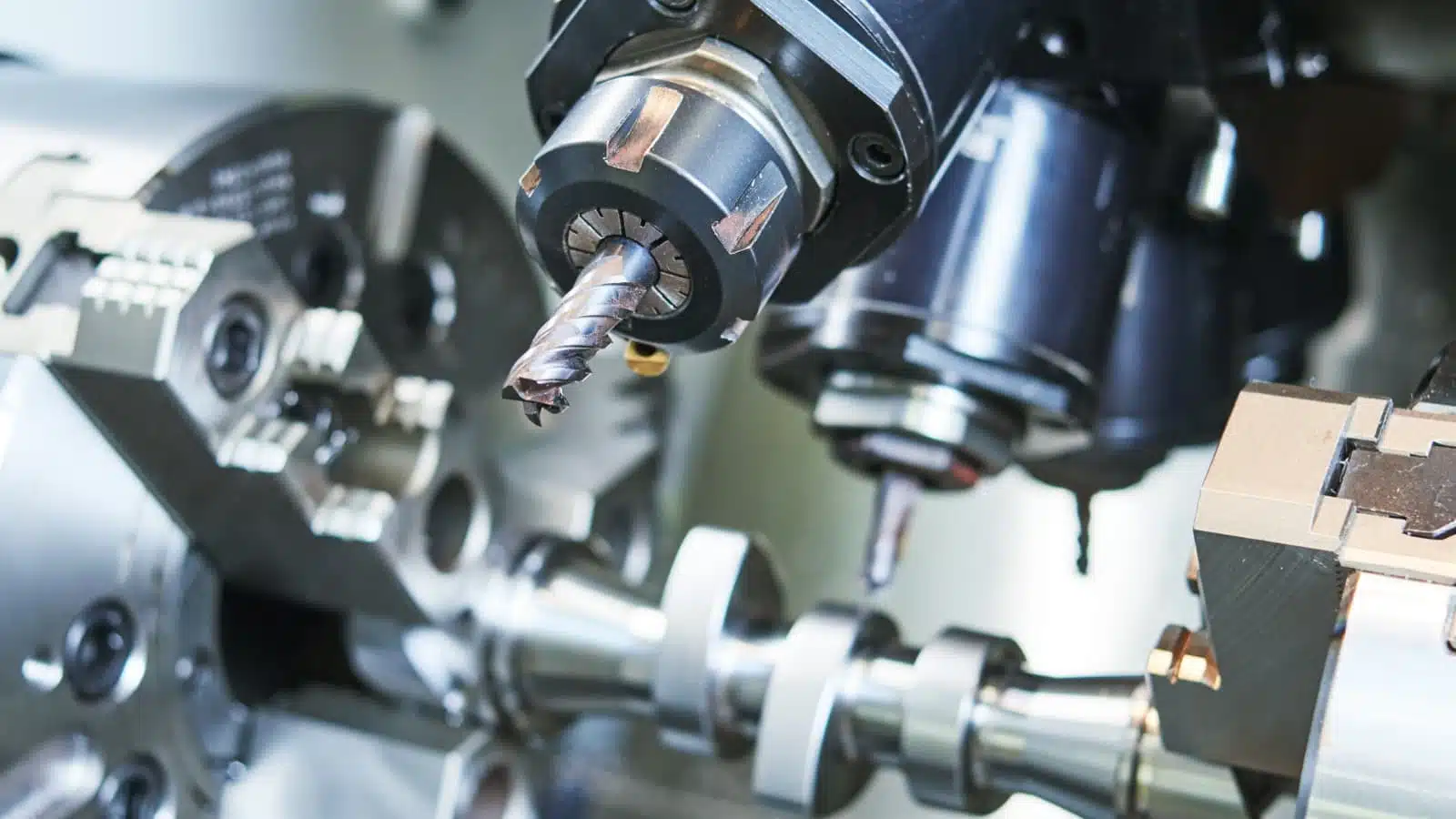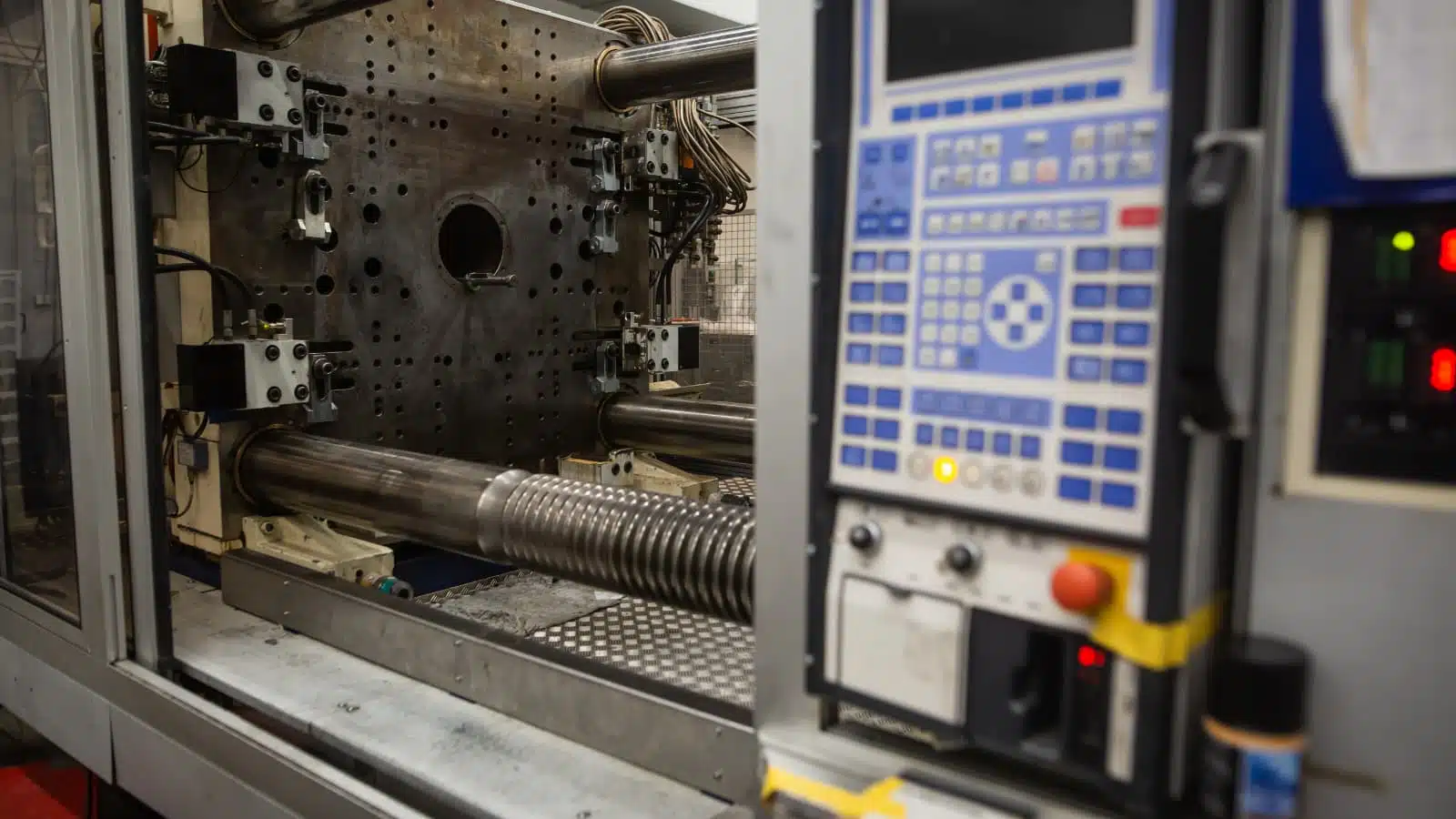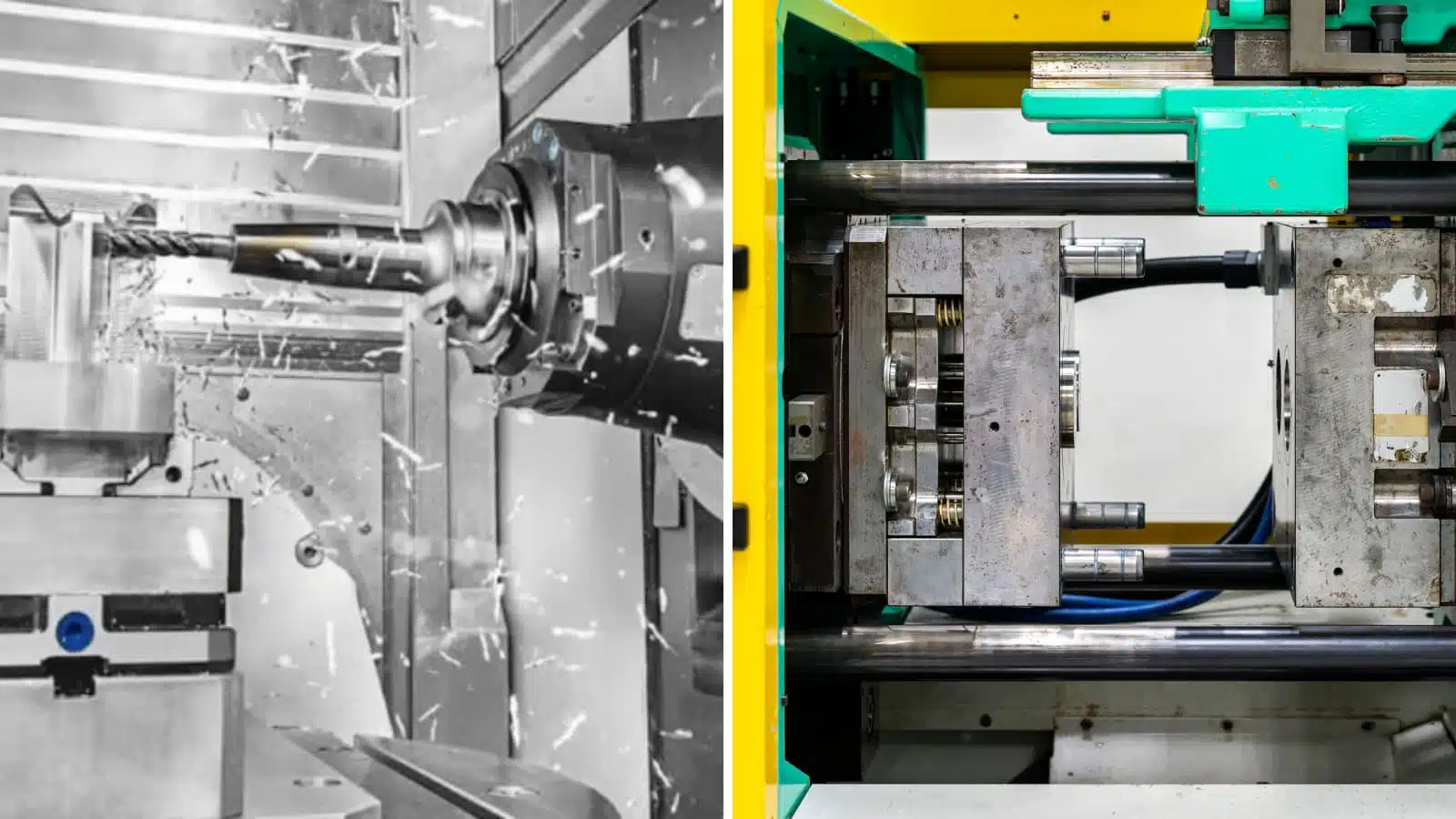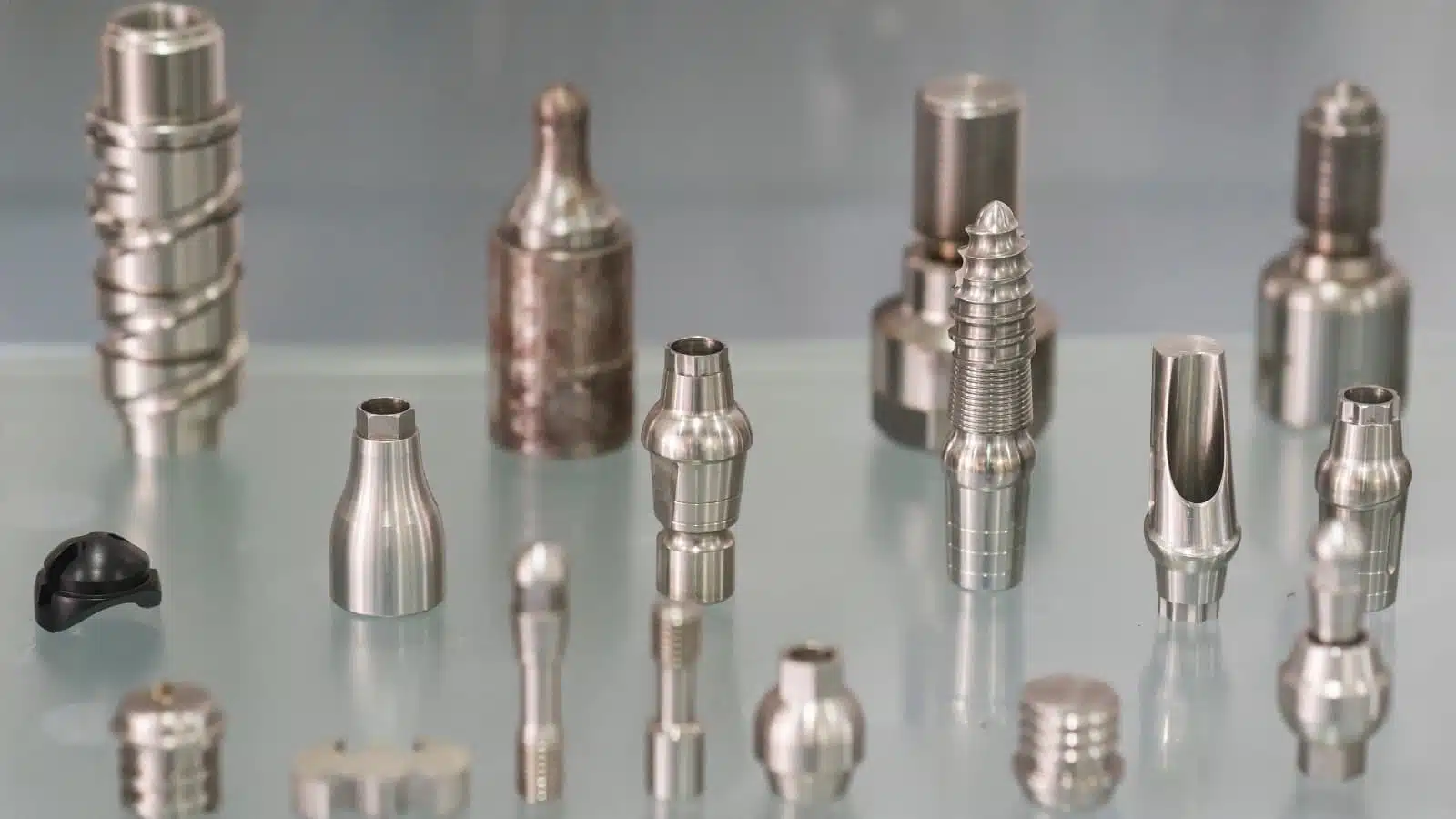Do you need clarification about CNC machining vs injection molding? Regarding which method can exact your requirements and project specifications. It extensively depends on the design you have. However, the distinct production efficiency, accuracy, lead time, and cost implications of these two techniques make it challenging to choose the right one. Moreover, they work on fundamentally different principles.
CNC machining creates the desired part by removing the material with cutting tools. In contrast, the injection molding method involves injecting the molten material into a mold that contains negative geometry of the desired shape.
Furthermore, we will cover different aspects of Injection molding and CNC manufacturing for analytic differentiation between these processes.
What’s CNC Machining?
It is a subtractive manufacturing method that stands for computer numerical control. The CNC machining process creates the designed shape by removing the material from the workpiece with the help of suitable cutting tools. In this process, pre-programmed computer software dictates the movement of tools and machinery. As a result, it allows for precise control of complex machinery.

The process begins with making a digital 2D and 3D design. This design acts as a blueprint for the CNC machine. Meanwhile, the CNC system interprets the design, transitioning from design to production. It converts it into numbers and coordinates, and you have to input the parameters like cutting rate, depth, etc. Then, these coordinates guide the machine’s movements to manipulate the workpiece shape.
Thus, it is crucial in industries requiring high levels of accuracy, such as aerospace, automotive, and medical.
Pros of CNC Machining
- The precision of CNC machining is exceptional. It can offer tolerances as low as 0.0001 inches.
- CNC machining is versatile. It works with various materials like Metals, plastics, and composites. Also, the CNC machines can quickly work with changes in part designs.
- There is no significant time and investment for tooling and molding in CNC machining. So, it provides rapid turnaround for prototyping and small batches.
Cons of CNC Machining
- The plastic CNC machining does not need a standard mold for mass production. So, it repeats the same steps for each cycle, making it costlier in the large production.
- The subtractive nature of CNC machining restricts its ability to achieve the same level of shape complexity and fine detailing as injection molding.
What’s Injection Molding?
The injection molding process makes the desired parts or products by injecting the molten material into an injection mold under pressure. The molds contain cavities according to the geometry of the intended shape. Upon cooling, the material solidifies into the desired shape. Finally, opening the mold and injecting the solidified parts completes the process. However, sometimes molded parts require post-machining or surface finishing treatments to meet the necessary specifications.
If we look at the setup of the plastic molding process, it involves three units: Mold, Injection, and Clamping unit.

Firstly, Injection Mold consists of two halves that come together to form the cavity into which the molten material is injected. Secondly, the injection unit heats and injects the material into the mold. It melts the plastic pellets and forces the liquid into the mold cavity through pressure. Thirdly, the clamping unit holds the mold halves tightly together during the injection and cooling. Once the material solidifies, the clamping unit opens the mold to eject the part.
Pros of Injection Molding
- This process is economical for large-scale production runs as a mold is usable for several thousand to millions of production cycles under proper maintenance.
- It molds materials into complex shapes with precision. It depends on the cavity intricacies.
- A single mold is applicable for multiple molding cycles. So, it produces parts with uniform precision and quality, ensuring high efficiency and repeatability.
Cons of Injection Molding
- Unlike CNC machining, it involves making a mold first before actual production. It makes injection molding costlier in CNC machining vs injection molding comparison.
- Not all materials are suitable for injection molding. It is commonly ideal for thermoplastic parts. Next, the mold design must accommodate the capabilities of molding machines, limiting creative flexibility.
- Developing and producing molds takes time. It can extend the overall timeline from concept to production, affecting project schedules.
CNC Machining vs Injection Molding: Key Differences
| Criteria | CNC Machining | Injection Molding |
| Material Diversity and Selection | It is compatible with more diverse materials, metals, plastics, and composites | Predominantly used for plastic materials. |
| Tolerances | As low as ±0.001”. | Typically ±0.003”. |
| Design Flexibility and Limitations | Capable of creating more intricate internal features like undercuts. | Less flexible for internal geometries |
| Time Efficiency From Prototype to Production | Quick, often a few hours to a week or month. | Time-consuming due to CNC mold making |
| Production Volume | Preferred for prototyping or small volumes. | Medium to large volumes |
| Final Product Quality and Precision | More precise and excellent as-machined surface finishes(Ra 0.8-3.2 µm) | Might require post-machining or processing |
| Tooling Longevity and Maintenance Requirements | Frequent tool replacement | A mold is applicable for numerous cycles |
| Cost-effectiveness for Different Production Volumes | Rapid prototyping to shot-run production | Identical parts in large numbers |
Deciding on injection molding vs CNC machining requires a detailed assessment of different technical capabilities and cost implications. Meanwhile, typical comparison criteria are material options, precision, quality, design flexibility, and cost-effectiveness. So, let’s compare these two manufacturing processes to determine the key differences.

Material Diversity and Selection
CNC machining is compatible with diverse materials, including metals, plastics, ceramics, and composites. This diversity allows for extensive material selection based on the specific needs of the intended application, such as strength, weight, or thermal properties. Conversely, injection molding is suitable for plastics and some metals. However, it offers a broad selection within these categories.
Tolerances
CNC machining is renowned for its capability to achieve tight tolerances. The CNC precision machining processes can achieve tolerances of ±0.001”. This precision is essential for industries where minute discrepancies can impact functionality.
On the other hand, injection molding offers slightly less tight tolerances (±0.003 mm) while still being precise. Subsequently, the nature of the molding process and material behavior during cooling can introduce variability.
Design Flexibility and Limitations
Injection molding can produce parts with complex geometries and intricate details, especially for parts that are challenging to machine. However, it requires designs to be moldable, considering factors like draft angles and undercuts.
On the other hand, CNC machining struggles with very complex internal geometries. However, it provides greater flexibility in design modifications because you can make adjustments simply by changing the program code.
Time Efficiency from Prototype to Production
If we analyze cnc machining vs plastic injection molding, which method is efficient for prototyping? The answer is CNC machining. Again, the reason is the additional mold-making process for injection molding prototyping. Meanwhile, CNC does not require mold creation.
As a result, transitioning from a CNC prototype to production is seamless, with adjustments easily made through programming. However, subsequent production cycles are rapid and accurate in injection molding once you create the mold
Production Volume
After the initial investment in injection mold, the cost of each subsequent cycle decreases as the same mold can repeat the numerous cycles. On the other hand, CNC machining is cost-effective for low to medium volumes, where the high injection mold cost is not feasible.
Final Product Quality and Precision
Although both processes deliver high-quality parts, CNC machining offers superior precision and surface finish directly off the machine. Injection molded parts might require additional finishing processes to achieve the desired surface quality. This post-processing is especially necessary for plastic injection molded parts with complex geometries or where the mold has begun to wear.
Tooling Longevity and Maintenance Requirements
The injection molds are subject to wear more than CNC tooling. So, it can be expensive to replace or repair in high-volume production runs. However, inspection and regular maintenance contribute to the consistent quality and longer life.
- Injection Mold: High cost and more longevity(from thousands to millions of cycles depending on the type of injection mold)
- CNC tooling: Less longevity, but economical for replacing.
On the other hand, CNC tooling (such as cutting tools, jigs, and fixtures) also requires maintenance over time. However, the cost of replacing these tooling is more economical than molding.
Cost-effectiveness for Different Production Volumes
The high upfront mold cost in injection molding can only justify the price with production in large volumes unless the designed part is only compatible with molding. The following list demonstrates the cost compatibility of injection molding vs CNC machining under different production volume scenarios.
- Prototyping: CNC machining is highly economical
- Small Batches: CNC machining
- Medium Volumes: CNC machining/ Injection molding based on specific scenarios
- Mass-production: Injection molding
On the other hand, CNC does not match the cost offered by low-cost injection molding in large volumes. As per CNC machining cost calculation, the per-unit cost decreases in less amount as volume increases.
What Are the Similarities of CNC Machining and Injection Molding?

We have discussed the fundamental differences between CNC machining and Injection molding. However, there are also a few similarities between these techniques. They can be very similar to plastic molded parts and machined plastic parts.
Precision and Accuracy
Computer numerical control makes CNC machining a precise method. Similarly, accurate mold and computer-controlled injection molding mechanisms can mold high-performance plastics with tight tolerances. So, both methods guarantee products meet strict specifications.
Complex Geometries
Another similarity is intricate geometry capabilities. The correct tooling and machining parameters can make complex geometry and features. Likewise, injection molding captures every design detail within its mold design considerations. Meanwhile, molding is superior for intricate patterns on thin plastic components.
Material Variety
Material versatility is another common ground. CNC machining processes a broad spectrum of materials, from metals and composites to plastics. This flexibility supports countless manufacturing needs. Injection molding parallels this with its capacity to mold various plastics. Each plastic type brings unique properties, from heat resistance to UV resistance. Thus, both technologies adapt to different material requirements.
Design Modification
Design changes are seamless in CNC machining because it relies on updating CAD files. For injection molding, mold modifications are possible before mass production. This adaptability facilitates rapid prototyping and iteration. It allows designers to refine the CNC machined products without significant cost or time investment. Therefore, both processes accommodate design modification.
Importance in Product Development
These methods accelerate the process from concept to market. They ensure prototypes match final product standards. You can use small injection molding machines to produce prototypes before full-scale runs. Moreover, both methods aid in swift production scaling. This importance is essential in competitive markets where speed and quality are critical. Thus, CNC machining and injection molding are crucial in bringing innovations to life.
Making Your Decision: Choose RapidDirect for CNC Machining and Injection Molding Services
From the above discussion, you might get an idea for choosing between CNC machining and Plastic injection molding. It depends on different factors: Material type, production volume, design complexity, and intended tolerances. However, it is wise to consult with industry experts like RapidDirect before your final decision. RapidDirect is a leading CNC machining service provider. The advanced multi-axis CNC systems at the RapidDirect factory can convert your design according to the desired specifications. Our engineers closely work with clients to clearly understand the requirements first. So, we can customize the products based on the intended use.
Furthermore, our injection molding services are tailored to produce high-quality injection molding plastic components with excellent surface finish. Subsequently, we also offer design modification and seamless scalability for high production runs. Meanwhile, you don’t have to think of mold making. Our dedicated team handles your advanced mold design and plastic mold manufacturing.
Upload your design and leverage the exceptional quality control and material options for your CNC machined and injection molded parts at RapidDirect!
Other Comparisons for CNC Machining or Injection Molding
CNC Machining vs 3D Printing
3D printing is an additive manufacturing method. It builds the design by adding the layers one by one. In contrast, the subtractive approach of CNC machining removes material to achieve the final part.
| Criteria | CNC Machining | 3D Printing |
| Strengths | Offers precision and strength | Excels in complexity and customization |
| Material Compatibility | Works with metals, composites, ceramics, plastics, and other materials. | Limited to polymers. But, can process some metals and composites. |
| Efficiency for High-Volume | More efficient but comes with higher setup costs | Not suitable for large-volume manufacturing. |
| Cost-Effectiveness for Small Batches | Lower cost | Cost-effective and allows for rapid prototyping with minimal setup |
CNC Machining vs Conventional Machining
Firstly, conventional machining is the foundation for whatever machining innovation we have today. It relies on manual operation. Skilled machinists guide the tools, offering flexibility and craftsmanship. Thus, conventional methods offer hands-on adaptability. In contrast, the computer automation of CNC makes it precise, efficient, and fast.
Although conventional machining is slower, it can compete with CNC in custom projects with medium tolerance. Here, the machinist’s expertise can navigate unique challenges. However, automated systems might not accommodate those challenges.
Subsequently, material wastage and cost implications further distinguish these two processes. CNC machining minimizes material waste and leads to cost savings in large-scale operations. On the other hand, conventional machines might produce more scrap. Yet, it requires a lower initial investment.
Injection Molding vs Die Casting
One common thing about these two methods is that they use a mold to shape the intended part. However, injection molding primarily uses thermoplastic and thermosetting polymers, whereas die casting is mainly for non-ferrous like aluminum, zinc, and magnesium. This fundamental difference in material compatibility dictates their use in various industries.
- Injection Molding: Plastics dominate industries like consumer goods and electronics
- Die Casting: Automotive and industrial components due to its metal processing capability.
Furthermore, low-pressure plastic injection molding enables precise & complex shapes. Conversely, die casting can produce high-strength parts with thinner walls and closer dimensional tolerances. So, it is ideal for metal and alloy parts. Next, injection molding is quicker and suitable for mass production.
Injection Molding vs Extrusion
Extrusion pushes material through a die, creating continuous shapes according to die design. It’s ideal for producing profiles like pipes and sheets. Thus, extrusion is about length and uniformity. On the other hand, injection molding focuses on detail and complexity.
| Aspect | Injection Molding | Extrusion |
| Process | Injects molten material into a mold | Pushes material through a die |
| Material | Primarily thermoplastics and thermosets | Plastics and metals like aluminum |
| Size | Suited for small to medium-sized parts | Best for long and continuous profiles |
| Speed | Fast cycle times for high-volume production | Also Fast |
| Precision | High precision with tight tolerance control | Consistent cross-sectional profiles but less precise than molding |
Subsequently, precision in injection molding is higher, offering tight tolerance control. Extrusion provides consistent cross-sectional profiles but with less dimensional accuracy than molding.
Compression Molding vs Injection Molding
Like injection methods, compression molding does not inject the material into a mold. Instead, the required material is first weighed and kept on the compression mold. Meanwhile, the mold cavities are often heated to improve the flow inside the mold during compression. This method is well-suited for large, simple-shaped, and durable parts in small to medium volumes. This method is well-suited for large, simple-shaped, and durable parts in small to medium volumes.
On the other hand, thermoplastic is the common injection molding material. It is highly efficient for large-scale production of small to medium-sized parts with fast cycle times. However, compression molding offers cost benefits for some projects by reducing waste and using simpler machinery.
Blow Molding vs Injection Molding
The blow molding process specializes in molding hollow objects such as bottles and containers. This process begins with melting the plastic and forming it into a preform or parison. Unlike injection molding, it is then inflated within a mold to achieve the desired shape.
It predominantly uses thermoplastic and suits for large volumes with uniform wall thickness. Injection molding, conversely, is adept at producing solid, intricate parts by injecting molten plastic into a mold at high pressure.
Conclusion
Finally, both processes are advantageous in manufacturing if you choose the right one based on your project specifications. The typical considerations for CNC machining vs Injection molding are material, shape complexity, production volume, wall thickness, and required tolerances.
Furthermore, there are other alternatives to plastic molding and CNC machining if these methods cannot address your design. You can choose from 3D printing, die casting, compression molding, and blow molding.


